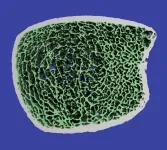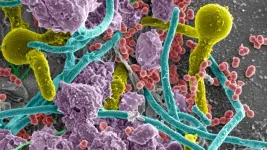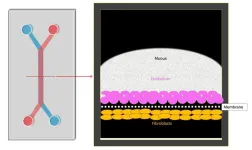(Press-News.org) Fralin Biomedical Research Institute at VTC scientists studying ultra-processed foods have created a new tool for assessing the rewarding and reinforcing properties of foods that make up 58 percent of calories consumed in the United States. The foods have been linked to a wide range of negative health outcomes.
The research, which was published in April in the journal Appetite, provides a collection of carefully curated images of minimally processed and ultra-processed foods matched on 26 characteristics, including macronutrients, sodium, dietary fiber, calories, price, and visual characteristics such as a color and portion size.
The work was based on the NOVA classification system — “nova” means new in Portuguese — which groups foods into four categories based on their level of processing. Nutrition researchers at the University of São Paulo in Brazil developed the scale while studying the country’s sharp increase in obesity rates.
The scale has its detractors.
“A major criticism of the NOVA scale is that it’s difficult to use or that foods are classified differently by different people,” said Alexandra DiFeliceantonio, corresponding author and assistant professor at the Fralin Biomedical Research Institute. “We found that people with education in nutrition generally agreed on the food classifications, providing some data that it might not be a valid criticism.”
What they did
The NOVA system assigns food to four categories: unprocessed or minimally processed, such as fresh fruit, legumes, or plain yogurt; processed culinary ingredients, such as cooking oils, butter, and salt; processed foods, which combine the two above through simple methods suc as cheese, canned vegetables, or freshly baked bread; and ultra-processed foods, such as soft drinks, flavored yogurt, processed meat, and most packaged breads, made through industrial processing and additives rarely found in a home pantry.
To develop the picture set, a team of psychologists, neuroscientists, and registered dietitians selected foods to represent either minimally processed or ultra-processed foods.
The foods were prepared in a lab, visually represented through professional photography, and controlled for consistency. Researchers also gathered price, food weights, and nutritional information – calories, macronutrients, sodium, and dietary fiber – for the food in each image.
Study participants rated images across a range of qualities to generate a final set of 28 pictures matched across 26 characteristics. To objectively measure NOVA classification, researchers recruited 67 nutrition professionals and asked them to classify the foods as minimally or ultra-processed.
“With this food picture set we can start to infer that any differences between food pictures is due to the degree of food processing, and not all these other factors that we know are potentially impactful,” said Zach Hutelin, the study’s lead author and a Fralin Biomedical Research Institute-based graduate student in the translational biology, medicine and health Ph.D. program.
Why this matters
Ultra-processed foods are linked with increased risk of developing obesity, Type 2 diabetes, heart disease, and cancer. They represent more than half of calories consumed in the United States, Canada, and the United Kingdom and have been identified as a global threat to public health.
“There is very little experimental research on ultra-processed foods, and part of what’s been holding us back is better tools for measuring and assessing their effects,” said DiFeliceantonio, who is also associate director of the Fralin Biomedical Research Institute’s Center for Health Behaviors Research. “The more tools we can provide, the more we can learn.”
The Virginia Tech team is making the pictures and associated data accessible through the Virginia Tech Data Repository of the Virginia Tech University Libraries. This will allow scientists to test hypotheses in behavioral economic and neuroimaging studies.
In the DiFeliceantonio lab, the photos are being used with functional MRI to reveal associated brain activity, with the images isolating the effects of food processing from other characteristics.
The study was funded by a National Science Foundation graduate research fellowship, the National Institute of Diabetes and Digestive and Kidney Diseases of the National Institutes of Health, and a grant from the Seale Innovation Fund, which supports innovative pilot research projects at the Fralin Biomedical Research Institute. DiFeliceantonio received a grant from the fund to investigate metabolic, neural, and behavioral data to better understand how our brains process nutrient availability and food preference.
Authors
Zach Hutelin, doctoral student, Translational Biology, Medicine and Health Graduate Program
Monica Ahrens, research scientist, Center for Biostatistics and Health Data Science, Virginia Tech
Mary Elizabeth Baugh, research scientist, Fralin Biomedical Research Institute at VTC
Mary Oster, Fralin Biomedical Research Institute at VTC
Alexandra Hanlon, director, Center for Director, Center for Biostatistics and Health Data Science, co-director, iTHRIV Biostatistics, Epidemiology and Research Design Methods Core, Virginia Tech
Alexandra DiFeliceantonio, assistant professor, Fralin Biomedical Research Institute at VTC, associate director, Center for Health Behaviors Research; assistant professor, Department of Human Nutrition, Foods, and Exercise, College of Agriculture and Life Sciences END
Virginia Tech scientists develop visual tool to help people group foods based on their levels of processing
Fralin Biomedical Research Institute at VTC team creates a set of images to help scientists, dietitians study foods
2024-05-31
ELSE PRESS RELEASES FROM THIS DATE:
Glimpses of a volcanic world: New telescope images of Jupiter's moon Io rival those from spacecraft
2024-05-31
New images of Jupiter's volcano-studded moon Io, taken by the Large Binocular Telescope on Mount Graham in Arizona, offer the highest resolution of Io ever achieved with an Earth-based instrument. The observations were made possible by a new high-contrast optical imaging instrument, dubbed SHARK-VIS, and the telescope's adaptive optics system, which compensates for the blurring induced by atmospheric turbulence.
The images, to be published in the journal Geophysical Research Letters, reveal surface features as small as 50 miles across, ...
Wake Forest University School of Medicine awarded $1.5 million from NIH to use advanced imaging to assess bone loss after bariatric surgery
2024-05-30
WINSTON-SALEM, N.C. – May 30, 2024 – Researchers at Wake Forest University of School of Medicine have received a five-year, $1.5 million grant from the National Institute of Arthritis and Musculoskeletal and Skin Diseases, part of the National Institutes of Health (NIH), to study bone microarchitecture in patients following bariatric surgery.
With the funding support, researchers at Wake Forest University School of Medicine will partner with Virginia Tech to add a virtual biopsy that uses an innovative technique called high-resolution peripheral quantitative ...
Researchers identify factors that heighten risk for catheter-associated urinary tract infections and sepsis
2024-05-30
Urinary catheters are required for nearly every surgical procedure. However, a major challenge for the health care industry is predicting who may develop catheter-associated urinary tract infections (CAUTIs) and when these infections may lead to death.
Now, a study from the University of Notre Dame has identified a population that is more susceptible to developing a CAUTI.
Researchers showed that models with fibrinolytic deficiencies, or conditions that cause overactivation of the protein fibrin, had increased risk for developing severe and persistent CAUTIs. ...
How community stress affects Black Americans’ mental health and wellbeing
2024-05-30
URBANA, Illinois – Residential segregation is an example of the long history of structural racism in the United States. Black Americans are more likely to live in low-quality neighborhoods, which contributes to disparities in health outcomes. A new study from the University of Illinois Urbana-Champaign looks at how community stress affects the mental and emotional health of Black men and women in the U.S.
“Community stress refers to the effects of living in disadvantaged areas. This includes objective aspects, such as buildings ...
Every drop counts: New algorithm tracks Texas daily reservoir evaporation rates
2024-05-30
Summer can be an extra challenging time for Texas’ 189 major water supply reservoirs. With temperatures consistently reaching 100 degrees or higher, reservoir evaporation rates see high increases.
Accurate evaporation rate estimates are crucial for water resource managers, as reservoirs play an essential role in our social and economic systems by supplying water for agricultural, municipal, and industrial consumption. Reservoirs are also critical for mitigating impacts from droughts and floods.
A recent study published ...
Study: Access to targeted lung cancer drug is cost-prohibitive globally
2024-05-30
MIAMI, FLORIDA (May 30, 2024) – Many countries with national healthcare systems or payers such as insurance companies use cost-effectiveness analyses to decide whether to cover new medicines, balancing treatment costs with potential health benefits.
That strategy often limits access to new, targeted therapies, even when these drugs prove highly effective and become part of standard-of-care therapy for many patients.
A new study from Sylvester Comprehensive Cancer Center at the University of Miami Miller School of Medicine examined the cost-effectiveness of durvalumab, a targeted immunotherapy for lung cancer that ...
Insilico Medicine President Alex Aliper, Ph.D. to present at Systems Aging Gordon Research Conference
2024-05-30
Alex Aliper, PhD, president of global clinical stage artificial intelligence (AI)-powered drug discovery company Insilico Medicine (“Insilico”) will present at the Systems Aging Gordon Research Conference, a leading international scientific conference focused on advancing the frontiers of science through the presentation of cutting-edge and unpublished research. On Wed., June 5, 10:40 am, Dr. Aliper will give a talk titled "Generative Artificial Intelligence and Next-Generation Robotics for Drug Discovery and Longevity Research."
The conference ...
ESA announces recipients of 2024 Awards
2024-05-30
The Ecological Society of America is pleased to announce the winners of its 2024 awards, which recognize outstanding contributions to ecology in new discoveries, teaching, sustainability, diversity and lifelong commitment to the profession.
These awards are designed to not only reward past achievements, but also to inspire a broad audience of scientists, educators and students, opening the door to new insights and collaborations that will further the impact of ecological research.
“The Ecological Society of America is immensely proud to honor this year’s distinguished awardees,” said ESA President ...
Novel mobile air monitoring technology yields greater insight into post-disaster pollution levels
2024-05-30
A team including researchers from the Texas A&M University School of Public Health and School of Medicine has found that high resolution mass spectrometry could be a valuable tool for identifying and assessing air-borne contaminants produced by natural and man-made disasters. Their findings were published in the Journal of Exposure Science & Environmental Epidemiology.
The scientists used high resolution mass spectrometry—a highly accurate means of identifying molecular compounds in a sample—in fall 2023 to identify volatile organic ...
Human cervix modeled in microfluidic organ chip fills key women's health gap
2024-05-30
Human cervix modeled in microfluidic organ chip fills key women's health gap
Engineered cervix with in vivo-like mucus production, hormone sensitivity, and associated microbiome creates novel testbed for bacterial vaginosis therapeutics and other treatments
By Benjamin Boettner
(BOSTON) — Bacterial Vaginosis (BV) has been identified as one of the many unmet needs in women's health and affects more than 25% of reproductive-aged women. It is caused by pathogenic bacteria that push the healthy microbiomes in the female vagina and cervix – the small gatekeeper canal that connects the uteruns and vagina – into a state of imbalance known as dysbiosis. ...
LAST 30 PRESS RELEASES:
Why nail-biting, procrastination and other self-sabotaging behaviors are rooted in survival instincts
Regional variations in mechanical properties of porcine leptomeninges
Artificial empathy in therapy and healthcare: advancements in interpersonal interaction technologies
Why some brains switch gears more efficiently than others
UVA’s Jundong Li wins ICDM’S 2025 Tao Li Award for data mining, machine learning
UVA’s low-power, high-performance computer power player Mircea Stan earns National Academy of Inventors fellowship
Not playing by the rules: USU researcher explores filamentous algae dynamics in rivers
Do our body clocks influence our risk of dementia?
Anthropologists offer new evidence of bipedalism in long-debated fossil discovery
Safer receipt paper from wood
Dosage-sensitive genes suggest no whole-genome duplications in ancestral angiosperm
First ancient human herpesvirus genomes document their deep history with humans
Why Some Bacteria Survive Antibiotics and How to Stop Them - New study reveals that bacteria can survive antibiotic treatment through two fundamentally different “shutdown modes”
UCLA study links scar healing to dangerous placenta condition
CHANGE-seq-BE finds off-target changes in the genome from base editors
The Journal of Nuclear Medicine Ahead-of-Print Tip Sheet: January 2, 2026
Delayed or absent first dose of measles, mumps, and rubella vaccination
Trends in US preterm birth rates by household income and race and ethnicity
Study identifies potential biomarker linked to progression and brain inflammation in multiple sclerosis
Many mothers in Norway do not show up for postnatal check-ups
Researchers want to find out why quick clay is so unstable
Superradiant spins show teamwork at the quantum scale
Cleveland Clinic Research links tumor bacteria to immunotherapy resistance in head and neck cancer
First Editorial of 2026: Resisting AI slop
Joint ground- and space-based observations reveal Saturn-mass rogue planet
Inheritable genetic variant offers protection against blood cancer risk and progression
Pigs settled Pacific islands alongside early human voyagers
A Coral reef’s daily pulse reshapes microbes in surrounding waters
EAST Tokamak experiments exceed plasma density limit, offering new approach to fusion ignition
Groundbreaking discovery reveals Africa’s oldest cremation pyre and complex ritual practices
[Press-News.org] Virginia Tech scientists develop visual tool to help people group foods based on their levels of processingFralin Biomedical Research Institute at VTC team creates a set of images to help scientists, dietitians study foods










